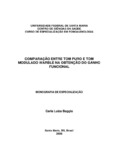| dc.contributor.advisor | Buss, Ceres Helena | |
| dc.creator | Baggio, Carla Luiza | |
| dc.date.accessioned | 2015-11-16T14:01:32Z | |
| dc.date.available | 2015-11-16T14:01:32Z | |
| dc.date.issued | 2006-01-26 | |
| dc.date.submitted | 2006 | |
| dc.identifier.uri | http://repositorio.ufsm.br/handle/1/1130 | |
| dc.description | Monografia (especialização) - Universidade Federal de Santa Maria, Centro de Ciências da Saúde, Curso de Especialização em Fonoaudiologia, RS, 2006. | por |
| dc.description.abstract | The functional gain is used in the validation of the process adaptation of hearing aids.
This research presented as main aim to perform a study comparing the use of pure
tone with the warble tone of the functional gain in users of hearing aid. To participate
of the research the patients they would have to take care with some criterious:
present bilateral sensorineural hearing loss, timpanometry curve type A (Jerger), use
binaural hearing aids digital, with two canals, to be in process adaptation and present
cognitive ability to understand the test instructions. The sample studied was made
with 16 patients between 62 and 90 years old. These people signed the free
permission term, answered the interview and they were submitted to tests in free
field. After the selection of the patients was realized hearing evaluation with and
without hearing aid in free field, using the frequencies 500, 1000, 2000, 3000 and
4000 Hz. On the basis of the results, had been established the values of reference
for the functional gain of hearing aid, with the different used tones. The results found
through the analysis statistics using the test Mann-Whitney had shown that
statistically significant difference was found between the mean of gain with pure tone
and with tone warble for all the analyzed frequencies. After the realization this study it
was, concluded that, the use of the tone warble, in the functional gain, to present
accurater results when comparative to the use of the pure tone in the frequencies of
2000, 3000 and 4000 Hz | eng |
| dc.language | por | por |
| dc.publisher | Universidade Federal de Santa Maria | por |
| dc.rights | Acesso Aberto | por |
| dc.subject | Ganho funcional | por |
| dc.subject | Prótese auditiva | por |
| dc.subject | Tom puro | por |
| dc.subject | Tom warble | por |
| dc.title | Comparação entre tom puro e tom modulado warble na obtenção do ganho funcional | por |
| dc.title.alternative | Comparition between pure tone and warble tone in the fucntional gain | eng |
| dc.type | Trabalho de Conclusão de Curso de Especialização | por |
| dc.degree.local | Santa Maria, RS, Brasil. | por |
| dc.degree.specialization | Fonoaudiologia | por |
| dc.description.resumo | O ganho funcional é utilizado na validação do processo de adaptação de
próteses auditivas. Esta pesquisa objetivou comparar o uso do tom puro com o
tom modulado warble na obtenção do ganho funcional em usuários de próteses
auditivas. Para participar da pesquisa os pacientes deveriam atender os
seguintes critérios: ter perda auditiva neurossensorial bilateral, timpanograma tipo
A (Jerger), usar próteses auditivas digitais binaurais, com dois canais, estar em
processo de adaptação e ter capacidade cognitiva para compreender as
instruções do teste. A amostra estudada foi constituída por 16 pacientes com
idade entre 62 e 90 anos. Os mesmos assinaram o termo de consentimento livre
e esclarecido, responderam à entrevista e submeteram-se a avaliação auditiva
em campo livre. Após a seleção dos pacientes foi realizada a avaliação auditiva
sem e com prótese auditiva em campo livre, utilizando as freqüências de 500,
1000, 2000, 3000 e 4000 Hz. Com base nos resultados, foram estabelecidos os
valores de referência para o ganho funcional da prótese auditiva, com os
diferentes tons utilizados. O resultado encontrado através da análise estatística
utilizando o teste de Mann-Whitney, mostrou que existe diferença
estatisticamente significante entre a média dos ganhos com tom puro e aquela
com tom modulado warble para as freqüências de 2000, 3000 e 4000 Hz. Após a
realização deste estudo, concluiu-se que o uso do tom modulado warble, na
obtenção dos valores do ganho funcional, apresenta resultados mais precisos
quando comparado ao uso do tom puro nas freqüências de 2000, 3000 e 4000
Hz. | por |
| dc.publisher.unidade | Centro de Ciências da Saúde | por |


